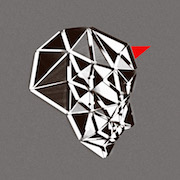Back in the late ‘80s and early ‘90s, Slowdive helped challenge the idea that a band setup could not be used to create the kind of ambience associated with synthesised music – something which became their constant point of reference, after the release of debut Souvlaki Space Station, produced with assistance from Brian Eno. They demonstrated, along with bands associated with the post-rock label in the ‘90s and early ‘00s, that a restricted rock band setup was an advantageous starting point for composers, allowing them to stem and manoeuvre creative inspiration into new areas. Amoral Avatar here produce an album which has less in common with bands like Explosions In The Sky and Godspeed You! Black Emperor and other post-rock bands that this ambience-focused ‘90s guitar music is somewhat reduced to: instead, this release draws from the original ambient inspirations of these artists, looking at music concrete and early 20th-century composition.
Collaborators Leo Abrahams and Chris Vatalaro take guitar tones into new space, music concrete influences worked in as a kind of rhythmic accompaniment to more familiar guitar-focused melodies. Interspersing his drum accents with those made by found objects, Chris Vatalaro has chosen to use these influences for the purposes of combining rhythms and juddering accents with novel textures. Vatalaro has used his time as a session percussionist with other experimental artists like Eno & Hyde and Steve Reich, to work as a useful point of reference on his own work in Amoral Avatar; for Leo Abrahams, this project is a diversion from his last album in 2013, Zero Sum, oriented towards more New Age guitar melodies. The pieces on this new collaborative work sound less finalised, with many of them ending abruptly – lacking the sentimentality of a cadence-based conclusion. Time and effort is instead spent on creating direction and a pointer towards an overall mood through heavily developed introductions.
First tracks ‘AA1’ and ‘AA2’ limit exploration to percussion textures, featuring unnervingly syncopated beats in a mid-range pitch, at a glance disjointed from the pitch bent guitar that follows from it. The discomforting textures produced by Vatalaro here stop the minimalism and ambience from slipping into mundanity; the duo are well experienced with ambient pieces and cannily sidestep its overly-familiar tropes. The percussion of ‘AA2’ suggests a kind of narrative, in what sounds like the rapid firing of a gun before a heavy crash. ‘AA3’ appears to feature Amoral Avatar’s most clear use of contact microphone, creating a steady illusion of closeness, urgency and pressure associated more with compression, the end result far cleaner than the one that could be possibly achieved through the limiting of dynamic range.
‘AA4’ is more typical of what is to follow in the album’s midsection – arpeggiated guitar being the central focus here: though even this is not derivative – the ambience from the guitar is not created via distortion and/or reverb but through the layering of the treated guitars that forms a drone. This retrogressive-sounding ambience arises from the combination of the two instrumental palettes of these musicians, seemingly at odds with one another but entirely complimentary. Abrahams approaches an influence from Ennio Morricone by adopting the ‘70s analogue synth Korg Polyphonic Ensemble; it’s not a synthesiser that Morricone would have used himself, despite having been originally released in the mid ‘70s, but it helps to recreate that spaciousness apparent on his Spaghetti Western soundtracks. Whilst the synth on ‘AA6’ is only present as a light anchorage rather than as an instrument to carry the melody, it gives the album a subtly symphonic sound. The use of guitar here is also sporadic, mainly utilised as a means to shift dynamic between different sections of the track.
With Amoral Avatar being 18 tracks long, it is a rather dense, intense experience when taken as a whole – but there is a cohesiveness apparent within it. After repeated listening, it is clear that the album is divided into sections that bare a similar focus – some passages are dedicated more specifically to exploring percussion ideas, others are more focused on the expansion of guitar melodies. Though the last few tracks slip into more of an alternative pop sound, comparable to the melancholy yet strangely emphatic 4AD artists This Mortal Coil or Cocteau Twins. What this all shows, however, is that this project has resulted in copious material – alluding to that rare capacity in new collaborations to create even further work together.


